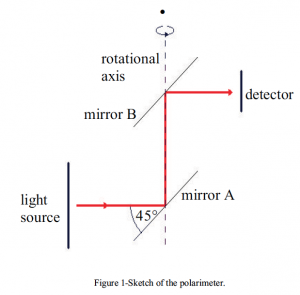Fabian Walter and Dr. R Steven Turley, Physics and Astronomy
Characterizing mirrors is of great importance when designing optical devices. In order to control the reflectivity, these mirrors are made of multilayer structures. The index of refraction n, which allows for the calculation of the reflectivity, depends on the wavelength of the light. In the XUV (extreme ultraviolet) regime, n is not well known and experiments to determine it have to be done under vacuum due to the absorption of XUV light by air. This complicates the performing of experiments with light of that wavelength.
The polarimeter is a device to determine n in the XUV regime. It consists mainly of two identical mirrors whose index of refraction is to be determined. These mirrors are mounted at 45 with respect to the incoming light beam (see figure 1). Rotating mirror B about the azimuthal angle á (without changing the incidence angle) changes the intensity of the light beam exiting the polarimeter. A formula that gives this intensity in terms of n and as a function of á had been found.
For a single layer I had shown that the by knowing the normalized intensity at an angle we could solve for n analytically. For a multilayer, however, n could not be solved for analytically. Therefore, a computer program was written, that calculated the intensity at a given azimuthal angle á using the index of refraction. This code was implemented into a routine that took reflection data for the mirror and adjusted the parameters (such as the index of refraction and thickness) of the model for that mirror until the formula was able to reproduce the data well. The fit formula can take many parameters such as the thickness of the one or more layers, the real part and the imaginary part of n. Calculations have shown that when fitting only one variable the others have be known very well, under some circumstances to within a percent. This means that in this case parameters such as thickness have to be determined reliably through other techniques.
Part of my work consisted of aligning the system. The XUV-light was provided by a plasma and a monochromator that had to be repaired and aligned which demanded more time than expected. The alignment was particularly difficult since a deviation from the 45 incidence implied a moving beam at the detector end. This would have made the measurements useless. Not hitting the rotational axis of the second mirror had the same effect. The position at which the beam had to hit the first mirror to coincide with the rotational axis of the second one depended of the thickness of the mirror. It was therefore necessary to machine a mechanism that would allow for the repositioning of the beam. The two challenges that had to be met were therefore assuring 45 incidence and hitting the right spot.
Since the work on the monochromator took more time that anticipated, we just recently were able to take measurements on the polarimeter. To test the its performance we used an SiO2 layer on an Si waver. The layer of SiO2 was the result of natural oxidation. So far I only fitted the data once with the thickness, the real and the imaginary part of the index of refraction of SiO2 set as fit parameters. The computer found a fit for the thickness around 20Å which was roughly expected. Yet, the values for the real and imaginary part of n could only be determined to within 20-30%. There are many sources for this unsatisfactory result but also ways to improve it. Although the computer looks for a fit, it has to be given initial values. A different fit routine could be used that indicates statistical facts about the fit allowing for systematic altering of these initial values. The performance of the fit routine should also be improved by changing the number of fit parameters. Furthermore, increasing the intensity of the incoming light beam would result in reflection data that is less prone to noise. This would increase the quality of the computer fit. My lab partner Raymond Rios, who has been of great help during this research and who will work on this project in the future is currently investigating the XUV-light beam with a CCD camera in an attempt to increase the intensity of the incoming light beam.
This project has been extremely valuable to me, since it introduced me to research in physics in many aspects. I had to learn important programming skills and study the theory of optics as well as computational methods. Also, I learnt how unexpected problems will come up, especially in experimental research. This project is of great importance, since it constitutes a simple and cheap method to determine the optical constant n. Although the more work on the taking of data and the computation has to be done I was glad to arrive at a point where I could put all my accomplishments together.

